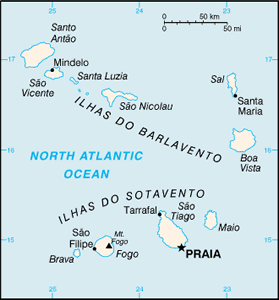The Geography of Cape Verde
The Geography of Cape Verde
Cape Verdean Geography
Location: Western Africa, group of islands in the North Atlantic Ocean, west of Senegal
Geographic coordinates: 16 00 N, 24 00 W
Map references: Political Map of the World
Area: total: 4,033 sq km land: 4,033 sq km water: 0 sq km
Area - comparative: slightly larger than Rhode Island
Land boundaries: 0 km
Coastline: 965 km
Maritime claims: measured from claimed archipelagic baselines territorial sea: 12 nm contiguous zone: 24 nm exclusive economic zone: 200 nm
Climate: temperate; warm, dry summer; precipitation meager and very erratic
Terrain: steep, rugged, rocky, volcanic
Elevation extremes: lowest point: Atlantic Ocean 0 m highest point: Mt. Fogo 2,829 m (a volcano on Fogo Island)
Natural resources: salt, basalt rock, limestone, kaolin, fish, clay, gypsum
Land use: arable land: 11.41% permanent crops: 0.74% other: 87.85% (2005)
Irrigated land: 30 sq km (2003)
Natural hazards: prolonged droughts; seasonal harmattan wind produces obscuring dust; volcanically and seismically active
Environment - current issues: soil erosion; deforestation due to demand for wood used as fuel; water shortages; desertification; environmental damage has threatened several species of birds and reptiles; illegal beach sand extraction; overfishing
Environment - international agreements: party to: Biodiversity, Climate Change, Climate Change-Kyoto Protocol, Desertification, Endangered Species, Environmental Modification, Hazardous Wastes, Law of the Sea, Marine Dumping, Ozone Layer Protection, Ship Pollution, Wetlands signed, but not ratified: none of the selected agreements
Geography - note: strategic location 500 km from west coast of Africa near major north-south sea routes; important communications station; important sea and air refueling site


